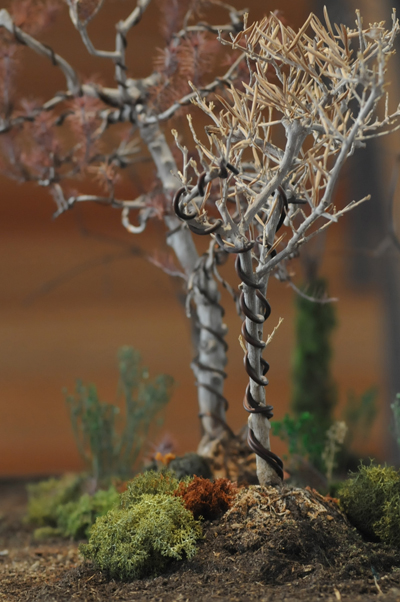Modern man cannot establish his relationship with nature as one of
domination (Descartes: lords and owners of nature) unless he
regards nature as a set of inert objects and society as subject to a
rational domain.
Cornelius Castoriadis
All places can be inhabitable spaces in the context of micro-communities which are continually being redefined
with the repeated use and reuse of a few square meters. As one's living space is reduced, the body adapts to the
progressive shrinking of these delimited surfaces, still able to guarantee some form of survival.
Urban progress has prepared the corners of life in the present day, one in which city dwellers become
increasingly restricted to the undefined limits of constructed areas. Architecture has redecorated, with grandiose
glass buildings held together by netting of steel cable and soldered iron, this project of an imaginary city erected
in an accumulation of images of body-objects blended with a state of nature that is forgotten and transformed.
Gabriela Albergaria works with nature through a set of concerns related with a loss of reference, or in other
words, the idea of a state of nature subjected to successive processes of humanization presented as unable to
survive in a world where the proliferation of spectres and simulations of natural environments supersedes reality
itself.
Through the pre-established processes of organization that take the surrounding space into consideration, the
artist reproduces a set of intervening actions between natural elements and technology as an application of
knowledge. In this way of pushing forward, there is a clear searching for a balanced solution, one which is not
aggressive toward that aspect which, presented as dislocated from its natural medium, emerges inevitably as
more fragile and dependent. For millions of years, nature dominated men, imposing limits on humanity with
regard to all types of survival-oriented activities. Presently, the idea of a natural world seems perfectly
controllable to us, even liable to be annulled in the name of underlying conceptions favouring notions of progress
and development, ones which are not in the least restrained by man's concern for satisfying his basic needs.
By maintaining oneself within the frame of reference which harkens back to an essential nature symbology, this
work endeavours to let loose processes of recuperation, not with respect to a return to a more pure original
conception, but instead directed toward the reproduction of a series of tasks requiring attentiveness and zeal,
with this duality resulting in a strong metaphysical charge.
This exhibition, under the auspices of the Vila Flor Cultural Centre, is based on the organizational lay-out of two
territories, taking off from completely distinct presentations of logic. In a contemporary approach that seeks to
develop and explore the particularities of a specific place, one that possesses an enormous historical component,
a set of pieces and ideas are brought together with the goal of sparking dialogues and confrontations amongst the
various elements present.
On the first floor, a group of work is presented, set up three-dimensionally along a length-wise perspective
(north-south) which suggests various mechanisms of closeness to nature. A drawing, as a type of fragmented
vision of a wooded environment made up of an exhaustive repetition of frames, proposes an ordering of
viewpoints overlooking the composition in a coherent space. On the opposite side, a series of trees is
reconstructed using discarded trunks and lifeless bits; in the centre a garden sample, seemingly untouched, is
placed on a table-top, suggesting the idea of transport and reintegration. Taking advantage of the recessed
windows along the side walls, two other box gardens are set up to develop a relationship of the sense of
prolonging, from the indoors to the outdoors.
On the second floor, which is divided into two areas and laid out east to west, the western windows and walls are
used to narrate some historical references about the Vila Flor Palace Gardens, taken from publications about the
edifice, which propose a type of reorganization of facts through the drawing of words. On the eastern wall, a
series of photographs of trees and branches are finished off with drawings.
The importance of this exhibition, and the work of Gabriela Albergaria in general, resides in the possibility
therein to find mechanisms of contractualization amongst the meaning contained in her work and the spaces
where it is inscribed. By avoiding the re-creation of forms which make biodiversity viable and sustain it, a role
which is currently the exclusive domain of Science, the artist is seeking, in the absurdity and strangeness of the
scenes presented, to unleash those free and unfettered actions that are able to surpass the presuppositions
directly related to the invalidation or protection of the environment.
Urban societies have transplanted nature to landscaped places that are weakened and digitally projected. A
scene-scape has been built upon the incoherent actions of planning for the conception of a new category of
biological being chosen only for its photogenic features. No one can really conquer spaces occupied by collective
disturbances and silliness, nor relive the extreme moments of survival from the past, ones which now get lost in
the expanse of human noise made out of dreams which cannot come true and, at the same time, produce crowds
of carefree abandoned people. Gabriela Albergaria addresses these and other themes in the reconstitution of a
new plasticity based on these remainders, on these sub-products of memory attached vehicle-like to a mutation
where manipulated images acquire a new life in the redefined imperfection of visions of the body.
TRANSLATION: DAVID ALAN PRESCOTT

